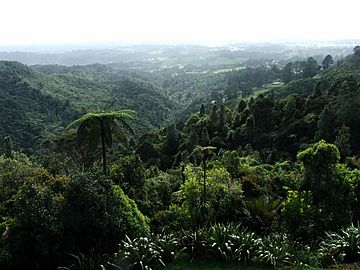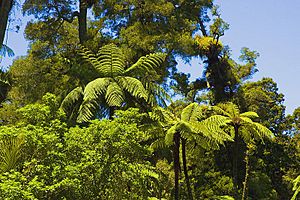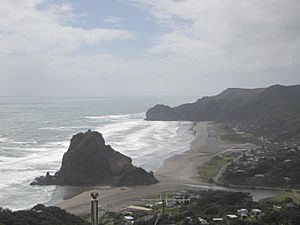Waitākere Ranges facts for kids
Quick facts for kids Waitākere Ranges |
|
|---|---|

A view of the Waitākere Ranges from Waiatarua in 2005, looking towards farmland in the Henderson Valley.
|
|
| Highest point | |
| Peak | Te Toiokawharu |
| Elevation | 474 m (1,555 ft) |
| Geography | |
| Country | New Zealand |
| Geology | |
| Age of rock | Miocene |
The Waitākere Ranges is a beautiful mountain range in New Zealand. It's located between the big city of Auckland and the wild west coast. This special area, including its hills and coasts, covers about 27,720 hectares (that's about 68,500 acres!) of both public and private land.
The Māori traditionally called this area Te Wao Nui o Tiriwa, which means "The Great Forest of Tiriwa." It's a very important place for local people, the wider region, and the whole country. The Waitākere Ranges are a chain of hills in the Auckland Region, stretching about 25 kilometres (15 miles) from north to south, about 25 kilometres west of central Auckland. This area is also part of the Waitākere Ranges Regional Park.
Since May 1, 2018, many parts of the Waitākere Ranges Regional Park's forests have been closed. This was done to protect the trees from a serious disease called Kauri Dieback. This disease is caused by a type of bacteria that stops kauri trees from getting the nutrients they need, which sadly kills them. There is no cure for it. The Auckland Council is working to upgrade walking tracks to help stop the spread of this disease. As of 2021, many tracks are still closed, and their future is not yet known.
Contents
What the Waitākere Ranges Look Like
The western coast of the Waitākere Ranges has amazing cliffs that are over 300 metres (984 feet) high! You'll find beaches here and there between the cliffs. These rugged hills were formed from very old volcanic rocks, like conglomerate and lava flows. These rocks were created by eruptions from a huge volcano called the Waitakere volcano, which was active 12 to 25 million years ago.
Most of the ranges are covered in native forest. This forest is growing back after a lot of trees were cut down for logging and farming in the late 1800s and early 1900s.
The highest point in the Waitākere Ranges is Te Toiokawharu. It stands tall at 474 metres (1,555 feet) and is located in the southern part of the ranges, about 3 kilometres (1.9 miles) north-east of Huia.
Early History of the Waitākere Ranges
The Te Kawerau ā Maki people have lived in the Waitākere Ranges area for a very long time. The Waitakere River and Te Henga (Bethells Beach) were important places for their settlements. Many parts of the coastline and river valleys were settled because the forests and coast provided lots of resources. Over 550 old archaeological sites have been found here!
More than 50 pā (fortified villages) were located around the Waitākere Ranges. Many caves and rock shelters were used as safe places during wars between the 16th and 18th centuries. For example, Lion Rock in Piha was once a Whakaari Pā, and there are caves in Whatipu that were also used.
Because of the weather conditions in the area, many old wooden and woven items have been preserved. In the early 1900s, surveys found pieces of traditional textiles like fishing nets, baskets, and parts of cloaks. These were found in places like Anawhata, Piha, Takatu Point, Karekare, and Whatipu.
The name Wai-tākere comes from a rock found in Waitākere Bay, near Te Henga (Bethells Beach).
The Waitākere Ranges Regional Park
The Waitākere Ranges Regional Park is a special protected area that covers about 17,000 hectares (42,000 acres). It has been protected for over 110 years through gifts of land, grants, purchases, and special laws. For example, in 1941, a law was passed to create the Auckland Centennial Memorial Park.
In 1894, a group led by Sir Algernon Thomas convinced the Auckland City Council to protect 3,500 acres (14 square kilometres) in the Nihotupu area of the ranges as a bush reserve. The national government then officially made this land, and other smaller areas, reserves to protect native plants and animals. Today, the Waitākere Ranges Regional Park covers about 39,500 acres (160 square kilometres). The area is also protected by a special law called the Waitākere Ranges Heritage Area Act of 2008.
This Act protects about 27,700 hectares (68,450 acres) of land, including both the public Waitākere Ranges Regional Park and privately owned land.
Fun Things to Do in the Waitākere Ranges
The Waitākere Ranges offer many exciting attractions:
- Beaches: There are four popular surf beaches: Piha, Muriwai, Te Henga (Bethells Beach), and Karekare.
- Walking Tracks: You can explore a huge network of bush walks and tracks.
- Amazing Views: Enjoy wide-open views of both the east and west coasts, and even the city of Auckland!
A road called Scenic Drive runs through a large part of the ranges, from Titirangi to Swanson. The Auckland Council has an information centre on Scenic Drive called the Arataki Visitor Centre, where you can learn more about the area.
The beaches on the west coast are known for their unique black sand. They can be dangerous for swimmers because of strong rip currents and big waves. To keep people safe, Surf Life Saving Clubs patrol special areas of the four most popular beaches during the summer. The Piha Surf Life Saving Club is the oldest, started in 1934.
On January 11, 2010, the Auckland Regional Council opened the Hillary Trail. This is a 77-kilometre (48-mile) trail that goes from the Arataki Visitor Centre to Muriwai, right through the Waitākere Ranges. It's named after the famous New Zealand mountaineer Sir Edmund Hillary. The Hillary Trail is considered one of the best multi-day hikes in the northern part of New Zealand.
Water for Auckland: Reservoirs
Five large reservoirs are located within the Waitākere Ranges. These reservoirs, including the Waitākere Reservoir and the Lower Nihotupu Reservoir, supply water to the Auckland region. Together, they provide about 26% of Auckland's drinking water!
The ranges get a lot of rain, averaging over 2,000 millimetres (78.75 inches) each year. This is more than double the rainfall in the city. When weather systems come across the Tasman Sea, the ranges block their path, causing what's called orographic rainfall. This means the air is forced upwards, cools, and releases its moisture as rain.
Animals of the Waitākere Ranges
The Waitākere Ranges are home to many interesting animals:
- Snails: You might find kauri snails here.
- Glowworms: Look out for glowworms, which light up the night.
- Bats: Native long-tailed bats live in the area. Long-tailed and short-tailed bats are the only native land mammals in New Zealand.
- Gannets: At the northern end of the ranges, Otakamiro Point is a special place where gannets breed. It's one of the few mainland breeding colonies in New Zealand.
- Invertebrates: The bush is full of native invertebrates (animals without backbones), including kauri snails, wētā (large crickets), and velvet worms. Some velvet worms have 14 pairs of legs, and others in the genus Peripatoides have 15 or 16 pairs of legs.
The Ark in the Park is a special conservation project. It's a partnership between Forest and Bird and the Auckland Council. They are working to bring back some animal species that had disappeared from the Cascades Kauri Park section of the ranges. This project started in 2003 and now covers 2,300 hectares (5,680 acres).
People Living in the Waitākere Ranges
The areas of Waitakere Ranges North and Waitakere Ranges South, which include places like Huia and Karekare (but not Piha or Te Henga), had a population of 2,385 people in the 2018 New Zealand census. This was an increase of 234 people since 2013.
Most people living here (92.3%) are of European/Pākehā background. About 12.5% are Māori, and smaller numbers are Pacific peoples or Asian. Many people (69.6%) said they had no religion.
Of the adults, about 28.6% had a university degree or higher, and 53.8% worked full-time.
See also
 In Spanish: Cordilleras Waitakere para niños
In Spanish: Cordilleras Waitakere para niños



